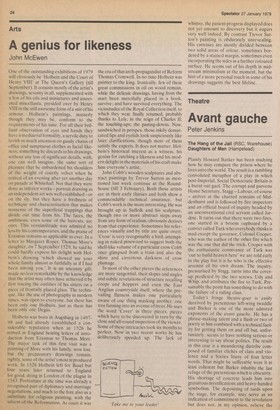Arts
A genius for likeness
John McEwen
One of the outstanding exhibitions of 1979 will obviously be 'Holbein and the Court of Henry VIII' at The Queen's Gallery (till September). It consists mostly of the artist's drawings, seventy in all, supplemented with a few of his oils and miniatures and associated miscellania. presided over by Henry VIII in the still awesome form of a suit of his armour. Holbe in's paintings, masterly though they may be. conform to the requirements of his time. For all their brilliant observation of eyes and hands they have a mediaeval formality, a servile duty to lavish as much attention on gaudy chains of office and sumptuous clothes as facial likeness; something he discards in his drawings, without any loss of significant details, with, one can well imagine, the same sort of pleasure that he unburdened his shoulders of the weight of courtly velvet when he retired of an evening after yet another day on parade at Whitehall. Not that they were done as inferior works — portrait drawing as an independent art was well established — or on the sly, but they have a freshness of technique and characterisation that makes nonsense of the superficial trappings that divide our time from his. The faces, the ambitions. even some of the haircuts, are ours. This verisimilitude was admired no less by his contemporaries, and the praise of Erasmus remains as applicable as ever. In a letter to Margaret Roper. Thomas More's daughter. on 7 September 1529. he said he could hardly express his delight with Holbein's drawing 'which showed me your whole family almost as faithfully as if I had been among you.' It is an uncanny gift. made no less remarkable by the knowledge that the artist may often have achieved it by first tracing the outlines of his sitters on a piece of frontally placed glass. The technique. like the use of photography in modern times. was open to everyone, but there has been only one Holbein. just as there has been only one Degas.
Holbein was born in Augsburg in 149798 and had already eastablished a considerable reputation when in 1526 he arrived in England bearing letters of introduction from Erasmus to Thomas More. The major task of this first visit was a painting of More with his family, now lost. but the preparatory drawings remain. rightly, some of the artist's most reproduced work. In 1528 Holbein left for Basel but four years later returned to England for good. dying in London of the plague in 1543. Portraiture at the time was already a recognised part of diplomacy and marriage negotiations. and much to the fore also as a substitute for religious painting, with the advent of the Reformation. At court it was the era of that arch-propagandist of Reform Thomas Cromwell. In no time Holbein was painter to the king. Ironically, few of these great commissions in oil on wood remain, while the delicate drawings, having from the start been mercifully placed in a book, survive; and have survived everything. The vicissitudes of the Royal Collection itself, to which they were finally returned, probably thanks to Lely, in the reign of Charles II; the touching-ups; the pasting-downs. Now. sandwiched in perspex, those inkily demarcated lips and eyelids look suspiciously like later clarifications, though most of them satisfy the experts. It does not matter. Holbein's historical interest as a witness, his genius for catching a likeness and his modern delight in the materials of his craft make him everyone's artist.
John Cobb's wooden sculptures and abstract paintings by Trevor Sutton as mentioned last week continue at the Roundhouse (till 3 February). Both these artists are in their early thirties and both show a commendable technical assurance, but Cobb's work is the more interesting. He was brought up in Suffolk and his sculpture, though two or more abstract steps away from any form of realism, obviously derives from that experience. Sometimes his references visually and by title are quite overt. 'Crow' is very recognisably a bird, attempting in naked pinewood to suggest both the shell-like volume of a particular crow Cobb once glimpsed from a train and also the shine and cavernous darkness of crow plumage.
In most of the other pieces the references are more tangential. their slopes and angles and subtle revelations of structure recalling coops and hoppers and even the East Anglian countryside itself, where the prevailing flatness makes one particularly aware of one thing masking another, one tree fanning into an avenue of trees. He uses the word 'Cover' in three pieces. pieces which have to be discovered in turn by the close and all-round inspection of the viewer. Some of these intricacies took six months to perfect. Now in two recent works he has deliberately speeded up. The lack of whimsy, the patient progress displayed does not yet amount to discovery but it augurs very well indeed. By contrast Trevor Sutton's painting is obdurately unrevealing. His canvases are mostly divided between two solid areas of colour, sometimes bordered by a stained margin, sometimes even incorporating the sides as a further coloured surface. He seems out of his depth in midstream minimalism at the moment, but the hint of a more personal touch in some of his drawings suggests the best lifeline.






































 Previous page
Previous page